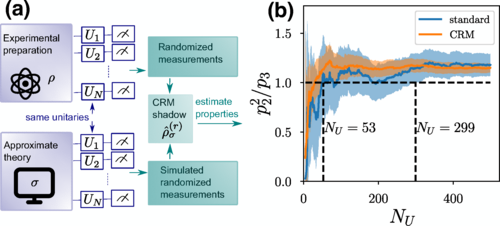Researchers from various institutions, including Université Grenoble Alpes and AWS Center for Quantum Computing, have developed a technique to enhance the estimation of quantum state properties. The method involves using approximate prior knowledge about the quantum state, performing randomized measurements on a quantum processor, and comparing the results with a classical computer. The technique reduces statistical errors and provides powerful estimators for multicopy observables. This advancement could improve the accuracy and efficiency of quantum computations, potentially leading to more reliable quantum computing applications and accelerating the development of quantum technologies.
What is the New Technique for Enhancing Quantum State Estimation?
A team of researchers from various institutions, including Université Grenoble Alpes, Institute for Theoretical Physics University of Innsbruck, Institute for Quantum Optics and Quantum Information of the Austrian Academy of Sciences, Institute for Quantum Information and Matter Caltech, and AWS Center for Quantum Computing, have developed a new technique for enhancing the estimation of quantum state properties. This technique involves incorporating approximate prior knowledge about the quantum state, performing randomized measurements on a quantum processor, and comparing the results with those obtained from a classical computer that stores an approximation of the quantum state.
The researchers provide unbiased estimators for expectation values of multicopy observables and present performance guarantees in terms of variance bounds that depend on the prior knowledge accuracy. They demonstrate the effectiveness of their approach through experimental and numerical examples, detecting mixed-state entanglement and estimating polynomial approximations of the von Neumann entropy and state fidelities.
How Does the New Technique Work?
The new technique is based on common random numbers. The researchers aim to estimate the expectation value of a random variable. If they estimate this value by averaging over multiple samples, the statistical error is quantified by the variance. However, if they have access to a random variable that is strongly correlated with the original variable, and whose average value is known, they can estimate the expectation value with reduced variance.
The researchers introduce common randomized measurements (CRMs). They start with standard randomized measurements that have been experimentally performed on a quantum state. To enhance the estimation of multicopy observables, they use approximate knowledge of the experimental state provided in the form of a classically representable approximation during the classical post-processing stage. This approximation can be derived from approximate theoretical modeling of the experiment or from data obtained in companion experiments.
What are the Benefits of the New Technique?
The new technique offers several benefits. Firstly, it reduces statistical errors for general multicopy observables by incorporating approximate knowledge of the quantum state of interest. This is relevant for estimating linear and nonlinear observables with reduced statistical errors.
Secondly, the technique allows for the construction of powerful CRM estimators for multicopy observables with reduced statistical error compared with the standard classical shadow approach. This is achieved by simulating classically randomized measurements on the approximation using the same random unitaries as applied in the experiment. If the experimental state and the approximation are sufficiently close, the results of the experimentally realized and simulated randomized measurements will be strongly correlated.
How was the New Technique Demonstrated?
To demonstrate the power of their approach, the researchers present analytical variance bounds based on combining results on multicopy observables and multishot shadow estimations, as well as two numerical examples. They note that the approximated state is typically available in experimental preparation.
The researchers also provide an illustration for entanglement detection using the experimental data. They show that experimental data from randomized measurements on a quantum state are combined with data from simulated randomized measurements on classical approximations to form CRM shadows for enhanced property prediction.
What is the Significance of this Research?
This research presents a significant advancement in the field of quantum computing. The new technique for enhancing the estimation of quantum state properties could potentially improve the accuracy and efficiency of quantum computations. By reducing statistical errors and providing powerful estimators for multicopy observables, the technique could pave the way for more reliable and robust quantum computing applications.
Moreover, the technique’s ability to incorporate approximate prior knowledge about the quantum state and to compare results from a quantum processor with those from a classical computer could bridge the gap between classical and quantum computing. This could lead to a better understanding of quantum phenomena and accelerate the development of quantum technologies.
Publication details: “Enhanced Estimation of Quantum Properties with Common Randomized Measurements”
Publication Date: 2024-03-28
Authors: Benoît Vermersch, Aniket Rath, Bharathan Sundar, Cyril Branciard, et al.
Source: PRX Quantum 5, 010352
DOI: https://doi.org/10.1103/PRXQuantum.5.010352

